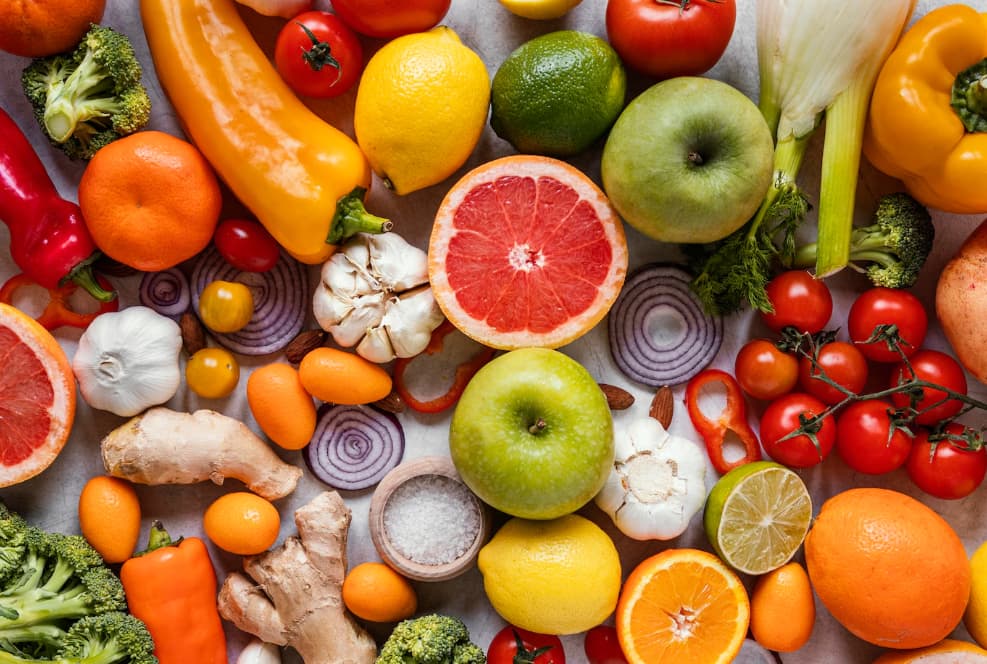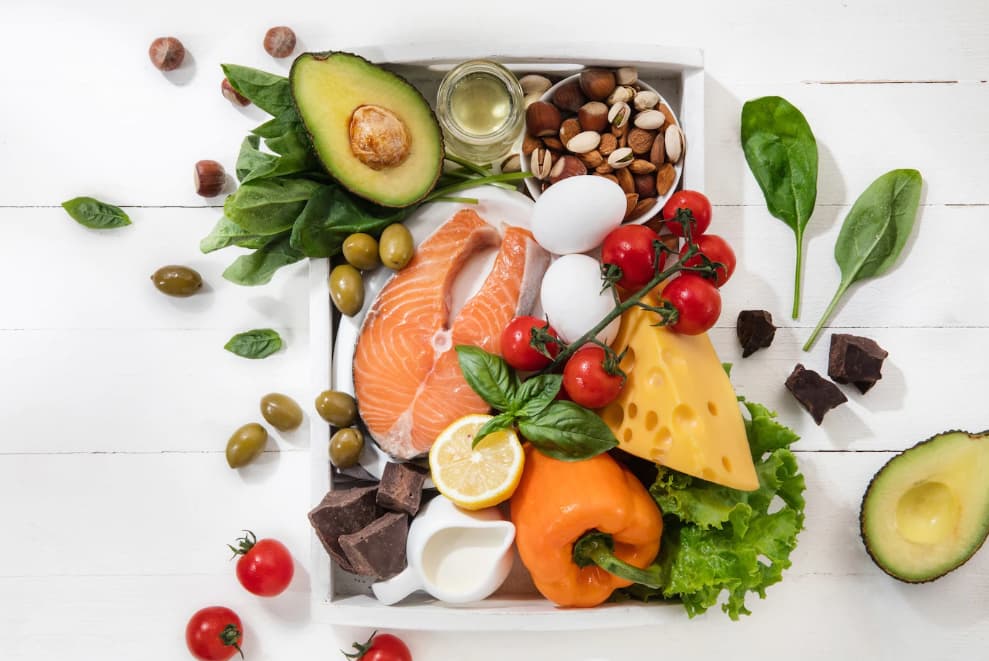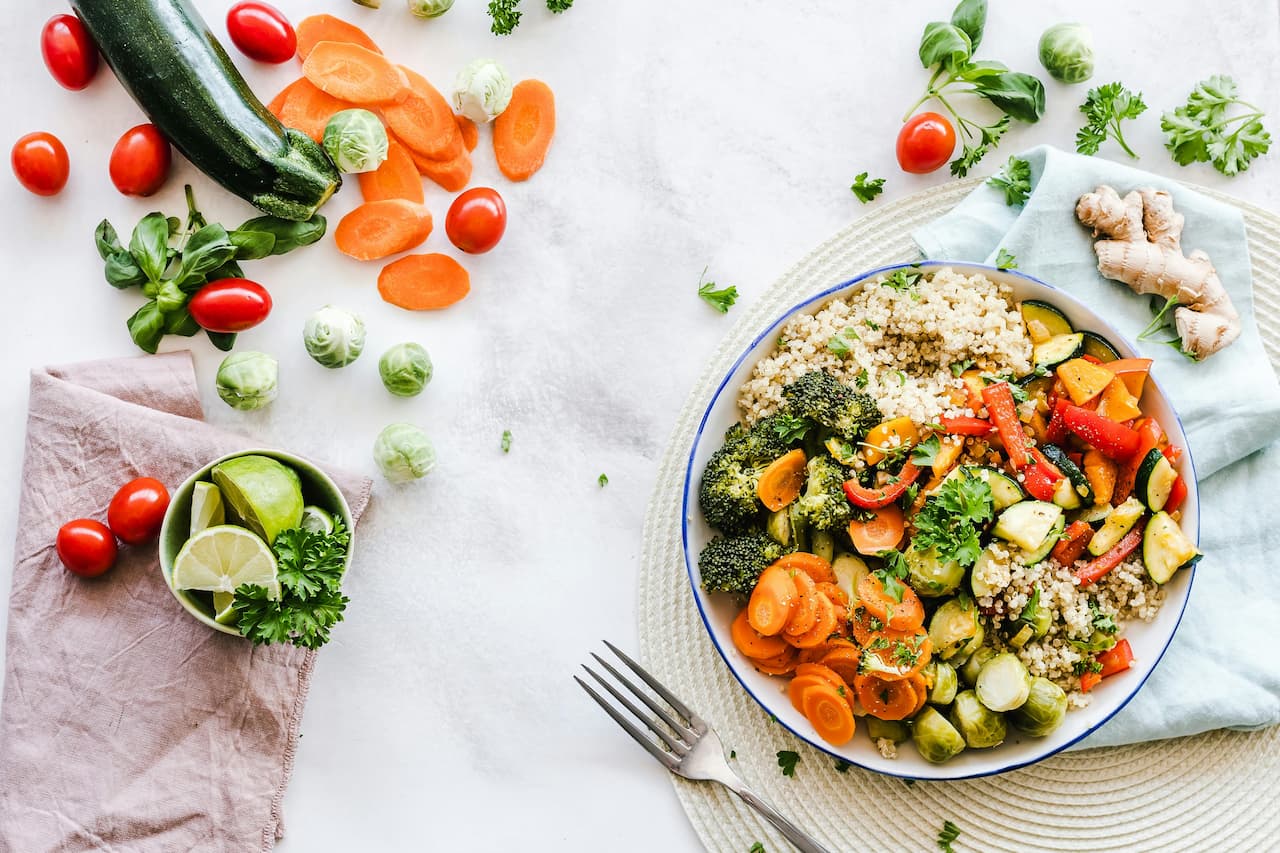Eating healthy is an important part of living a healthy lifestyle. By following some simple steps, you can make sure that you are getting all the essential nutrients and vitamins you need for a balanced diet. Here are 10 simple steps to eating healthier:
1. Start by taking stock of what you’re currently eating. Look at the ingredients in the food you’re consuming, and try to determine if it’s providing your body with the nutrients it needs. Are you getting enough fruits, vegetables, proteins, and whole grains? If not, make changes accordingly.
2. Make sure to include a variety of different foods in your diet. Eating the same things day after day can get boring and can even lead to nutritional deficiencies. Instead, try to include a wide variety of fruits, vegetables, proteins, and whole grains in your meals.
3. Reduce your intake of processed and refined foods. These foods are often full of unhealthy fats, sugar, and sodium, and should be avoided when possible. Instead, opt for natural, unprocessed foods such as fruits and vegetables.
4. Eat plenty of fiber. Fiber helps keep your digestive system running smoothly and can help prevent constipation. Aim to include at least 25 grams of fiber in your daily diet.
5. Drink plenty of water throughout the day. Staying hydrated is an essential part of staying healthy, so make sure to drink at least 8 glasses of water per day.
6. Try to limit your intake of saturated fats and trans fats. These types of fats can increase your risk of heart disease, so it’s important to limit their intake as much as possible.
7. Avoid added sugars as much as possible. Added sugars can lead to weight gain and other health problems, so try to find alternative sweeteners such as honey or maple syrup instead.
8. Cut back on salt and sodium intake as much as possible. Too much salt can raise your blood pressure, so try to limit your daily intake to no more than 2,300 milligrams per day.
9. Pay attention to food labels when grocery shopping. Look at the nutrition facts label on food packages and choose products with less fat, sugar, and sodium content whenever possible.
10. Enjoy your food! Eating healthy doesn’t have to be boring or unpleasant – experiment with different flavors and recipes to find dishes that you enjoy!
Following these 10 simple steps can help you achieve a healthier diet that will provide your body with all the essential vitamins and minerals it needs for optimal health. Remember, every step counts – so take small steps towards healthier eating today!
How to Create a Healthy Eating Plan
Creating a healthy eating plan is essential for leading a healthy lifestyle. A healthy eating plan consists of a variety of nutrient-dense foods that provide the body with the energy and nutrients it needs to function properly. To create a healthy eating plan, you must first consider your lifestyle and nutritional needs.
The first step in creating a healthy eating plan is to assess your current diet. Make a list of all the foods you typically eat in a day, paying attention to portion sizes and types of food. Consider the amount of fruits, vegetables, grains, proteins, and fats in your current diet. You can use this list as a starting point for creating a healthier eating plan.
Once you’ve assessed your current diet, it’s time to start making changes. Start by adding more fruits and vegetables to your meals. Fruits and vegetables are packed with vitamins, minerals, and fiber that can help keep your body healthy and energized. Aim to include at least one fruit or vegetable at every meal. It’s also important to choose whole grains over refined grains, as whole grains are higher in fiber and other essential nutrients.
In addition to increasing your intake of fruits, vegetables, and whole grains, it’s important to choose healthy proteins and fats. Choose lean sources of protein like chicken, fish, beans, nuts, and eggs. Healthy fats include avocados, nuts, seeds, and olive oil. Limit saturated and trans fats as much as possible.
It’s also important to watch your portion sizes when creating a healthy eating plan. Eating too much can lead to weight gain and other health problems. Aim to fill half of your plate with fruits and vegetables, one-fourth with lean protein sources, and one-fourth with whole grains or other healthy carbohydrates.
Finally, make sure to drink plenty of water throughout the day to stay hydrated. Water helps your body function properly and can help you feel fuller longer. Aim for 8-10 glasses of water each day.
Creating a healthy eating plan can seem overwhelming at first, but with some dedication and planning you can easily create a nutritious meal plan that works for you. Incorporating nutrient-dense foods into each meal will help keep you energized and provide your body with the nutrients it needs to stay healthy.
Eating Healthy on a Budget
Eating healthy on a budget is a great way to stay in shape and have more energy throughout the day. It can be difficult to find the time and money to buy healthy foods, but it is possible. With a little bit of planning and creativity, you can make sure you are getting the nutrition you need without breaking the bank.
The first step is to make a plan. Decide what types of healthy foods you want to eat each week, and then create a shopping list. Try to include a variety of fresh fruits and vegetables, whole grains, lean proteins, and healthy fats. Look for items that are in season and on sale. If you shop at farmers markets, you can often find cheaper prices than at the grocery store.
Once you have your list, create meals for the week that use all of the ingredients you bought. You can also plan to have leftovers for a few days so you don’t have to cook every night. You can also save time by making larger batches of food, such as soups and stews, that you can freeze and eat later in the week.
In addition to buying healthy food, there are other ways to save money while eating healthy. For example, if you are eating out, look for restaurants that offer healthy options at a lower price. You can also look for coupons or discounts on healthy food items.
Finally, don’t be afraid to get creative with your meals. Try adding different spices and herbs to your recipes to add flavor without increasing calories or fat. You can also use cheaper ingredients like beans and lentils in place of more expensive proteins like beef and chicken.
Eating healthy on a budget is possible with a little bit of planning and creativity. By making smart choices at the grocery store and getting creative in the kitchen, you can make sure you are getting the nutrition you need without spending too much money.
7 Tips for Eating Healthy at Home
Eating healthy at home is a great way to stay healthy and energized throughout the day. With the right tips, you can make sure you’re eating nutritious meals without feeling deprived. Here are 7 tips for eating healthy at home:
1. Plan your meals ahead of time. Planning ahead can help you make healthier choices and save you time in the long run. Plan out your meals for the week and make a grocery list accordingly. When you shop, stick to your list and focus on buying whole, unprocessed foods.
2. Eat breakfast every day. Eating a nutritious breakfast is an important part of maintaining a healthy lifestyle. Start your day with a breakfast that includes complex carbohydrates, healthy fats, and protein to keep you full and energized throughout the day.
3. Choose healthy snacks. Snacking between meals can be a great way to get in extra nutrients and energy, but it’s important to make smart choices when it comes to snacks. Choose snacks that are high in fiber, protein, and healthy fats, like nuts, seeds, nut butters, and whole fruits and vegetables.
4. Incorporate plant-based proteins into your meals. Plant-based proteins are great sources of essential vitamins and minerals and can help you meet your daily protein needs without consuming animal products. Try incorporating plant-based proteins like beans, lentils, tempeh, and tofu into your meals for an extra boost of nutrition.
5. Get creative with your ingredients. If you’re feeling stuck in a rut with your meal planning, try experimenting with new ingredients or recipes to keep things interesting. This can help you discover new flavors and dishes that you may not have tried before.
6. Prepare meals in bulk. Meal prepping is a great way to ensure that you have healthy meals on hand throughout the week. Make large batches of soups, stews, casseroles, or grain bowls on the weekends so that you can easily reheat leftovers during the week.
7. Take some time to enjoy your meals. Eating healthy doesn’t have to be boring or bland – it can be an enjoyable experience! Take some time to savor your food and enjoy the flavors and textures of your meal without distractions from phones or screens.
Understanding the Benefits of Eating Healthy
Eating healthy is one of the most important things a person can do to maintain a healthy lifestyle. Eating healthy not only helps keep your weight in check, but it also provides numerous other benefits that are often overlooked. Here are some of the major benefits of eating healthy:
1. Improves Overall Health: Eating a balanced diet with plenty of fruits and vegetables, whole grains, and lean proteins can help improve your overall health. Eating healthy helps reduce the risk of chronic diseases such as heart disease, diabetes, and cancer. It also helps to boost your immune system, which can help you fight off illnesses more easily. Eating healthy also keeps your energy levels up so that you can stay active and productive throughout the day.
2. Enhances Brain Function: Eating a healthy diet has been linked to improved brain function. Studies have shown that those who eat a healthy diet are more likely to have better memory, focus, and concentration. Eating a diet full of fruits and vegetables, lean proteins, and whole grains can also help reduce the risk of Alzheimer’s disease.
3. Helps You Maintain a Healthy Weight: One of the most obvious benefits of eating healthy is that it can help you maintain a healthy weight. Eating a balanced diet with plenty of fruits and vegetables, whole grains, and lean proteins can help you feel full for longer periods of time, which can prevent overeating or snacking on unhealthy foods. Eating healthy also helps regulate your metabolism so that you can burn more calories throughout the day.
4. Improves Mood: Eating healthy has been linked to improved mental health and emotional wellbeing. Eating a balanced diet helps ensure that your body is getting all of the nutrients it needs to function properly, which can help reduce stress levels and improve mood. Eating healthy foods such as fruits and vegetables can also provide essential vitamins and minerals that can boost mood and reduce anxiety.
5. Strengthens Bones and Muscles: Eating healthy can also help strengthen your bones and muscles. Eating plenty of calcium-rich foods such as dairy products, leafy greens, nuts, and beans can help strengthen bones and teeth. Eating lean proteins such as fish, chicken, eggs, and tofu can also help build muscle mass.
Eating healthy is an essential part of maintaining a healthy lifestyle. Not only does eating healthy provide numerous physical benefits, but it can also improve your mental health and emotional wellbeing as well. Eating a balanced diet full of fruits and vegetables, whole grains, and lean proteins can help you feel energized throughout the day and reduce the risk of chronic diseases such as heart disease, diabetes, and cancer. So start incorporating more healthy foods into your diet today to reap all of the amazing benefits!
How to Make Healthy Food Taste Delicious
Eating healthy can sometimes be a struggle, especially when it comes to making meals that are not only nutritious but also taste delicious. The good news is that there are a few simple tricks you can use to make even the healthiest foods taste great.
One of the best ways to make healthy food taste delicious is to experiment with herbs and spices. Not only do herbs and spices add flavour, they also add nutrition. For example, using basil or oregano can add a bright, fresh flavour to any dish. Meanwhile, cumin, coriander and turmeric can give dishes a warm, earthy flavour. You can also experiment with different combinations of herbs and spices to find the perfect balance for your taste buds.
Another way to make healthy food taste delicious is to use fresh ingredients. Fresh fruits and vegetables have so much more flavour than their canned or frozen counterparts, so try to use them whenever possible. If you don’t have time to buy fresh ingredients, you can always keep some frozen fruits and vegetables on hand for quick and easy meals.
When cooking healthy meals, it’s also important to pay attention to texture. If a dish is too mushy or too dry, it won’t be as enjoyable to eat. To make sure your dishes have the right texture, you’ll want to pay attention to how long you cook them and how much liquid you add. For example, if you’re making a stir-fry, you’ll want to cook the vegetables until they are just tender and add a little bit of oil or broth to prevent them from drying out.
Finally, don’t forget about condiments and sauces. These can really bring out the flavours in healthy dishes and make them more enjoyable. Some great options include salsa, pesto, hummus, guacamole and tzatziki. Just remember to keep your portion sizes in check so that you don’t overdo it on the added calories.
Making healthy food taste delicious doesn’t have to be complicated or time consuming. With the right combination of herbs and spices, fresh ingredients and condiments, you can create delicious meals that are packed with nutrition and flavour. So don’t be afraid to get creative in the kitchen!

Increasing Your Intake of Nutritious Foods
Increasing your intake of nutritious foods is an important step towards living a healthy and balanced lifestyle. Eating nutritious foods can help you maintain a healthy weight, reduce your risk of chronic diseases, and improve your overall health. There are many ways to increase your intake of nutritious foods, such as adding more fruits and vegetables to your meals, incorporating whole grains into your diet, and choosing lean proteins.
Fruits and vegetables are excellent sources of vitamins, minerals, and fiber. They are also low in calories and fat. To increase your intake of fruits and vegetables, try adding them to your meals or snacks. You can add berries to oatmeal or yogurt, have a salad for lunch, or snack on carrot sticks or celery with hummus. You can also try adding vegetables to your favorite dishes, such as spaghetti sauce or casseroles.
Whole grains are a great way to add fiber and essential nutrients to your diet. Whole grains provide a variety of health benefits, including helping to reduce the risk of heart disease and diabetes. To increase your intake of whole grains, try adding them to salads or soups, having oatmeal for breakfast, or adding quinoa or brown rice to stir-fries or casseroles.
Protein is an important part of a healthy diet. It helps build muscle, repair tissue, and keep you feeling full. To increase your intake of lean protein, try eating more lean meats such as chicken or fish, adding beans or tofu to salads or stir-fries, or having a hard-boiled egg for a snack.
In addition to increasing your intake of nutritious foods, it’s important to limit unhealthy foods such as processed snacks, sugary drinks, and fried foods. Eating these types of foods can lead to weight gain, high cholesterol levels, and other health problems. It’s also important to drink plenty of water throughout the day to stay hydrated and maintain good health.
Increasing your intake of nutritious foods can help you maintain a healthy weight, reduce your risk of chronic diseases, and improve your overall health. Try adding more fruits and vegetables to your meals, incorporating whole grains into your diet, and choosing lean proteins. You should also limit unhealthy foods such as processed snacks and sugary drinks. By making these changes to your diet, you can enjoy the many benefits of eating nutritious foods.



